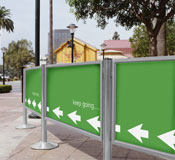Stadium events are naturally going to be crowded. And while these crowds are an expected and exciting part of the stadium experience, patrons do expect and appreciate a well-managed crowd control approach. For events with an established “start” and “stop” time, there are unique crowd management needs—on the way in and on the way out. And it’s at these moments where some established best practices and tools for the “ins” and “outs” of stadium crowd control come into play.
Clear and simple signage points the way in and out.
Double-sided, stand-alone signs with simple commands put people at ease and can direct incoming traffic before an event (“Enter here”) and be flipped around and relocated, if necessary, as an event ends (“Exit here”). Even signage indicating restrooms (“Nearest restroom to Parking Lot A”) can help crowds go with the flow rather than fight to go back in another direction just because their child drank too much soda and won’t make it home without a pit stop. Clear, bold signage can be easily deployed before an event wraps up to make sure the dispersing crowds get out swiftly and end up right where they want to be while limiting confusion (“Exit Here for Level 2 Parking”). Post-top signage, digital signage, and even poster display sign stands get the message across.

Think stable yet movable.
Stanchions with retractable belts or rigid rails are the tried and true way of directing traffic in and out of a stadium during in-and-out rushes. And while you want these stanchions to be secure, you may also need the ability to quickly reconfigure based on whether the crowds are coming in or going out. Removable semi-permanent post-mounting options (heavy duty magnetic bases, for example) are ideal for stanchions at entrances and exits. Semi-permanent means they’re strong enough to handle the flow of crowds as they’re arriving, but also easily movable when it’s time to have the same level of crowd control for departing guests. Posts can be added or removed based on crowd flow.
Make crowd control equipment transportable.
There are very few stadiums that are reserved solely for one type of event. When the use of a stadium varies, so can the traffic flow, which means the signage and stanchions used to direct and control the accompanying crowds must be reconfigured and adjusted quickly and easily. For example, back-to-back circus shows will be busy and crowded – and you don’t want folks trying to exit and enter through the same door at the same time. Post transporters make it a breeze to move extra stanchions as necessary from the entrance area of the event to the opposite end of the stadium for designated exits, so an appropriate configuration for the incoming crowds can be created while exiting crowds can also be accommodated.
Go beyond the front doors.

The job of managing crowd control rarely ends once people have exited through the doors of the facility. For that matter, crowd control doesn’t necessarily begin only as people are walking through the doors. If a venue also offers a parking lot or garage, it’s necessary to guide folks in and out of that part of the facility as well. Portable, long-belted safety barriers are capable of quickly blocking off large areas when a lot has filled up. They can also be used to direct exiting stadium-goers in a particular direction when combined with signage (“Cash Line Only” or “Credit Card Payments Here”). A single person should be able to deploy this traffic-controlling solution in a matter of minutes, dispersing stadium visitors easily and as speedily and safely as possible. What are the right entrance and exit strategies for your stadium? Learn more from a Lavi crowd control expert today.












